Leadership Strategies for Change Management at United Products
VerifiedAdded on 2023/06/10
|18
|4388
|264
Report
AI Summary
This report provides a comprehensive analysis of leadership in change management, drawing on a case study of United Products. It examines the forms of resistance to change, remedial actions taken by management, and the change management skills demonstrated by the CEO. The report further explores negotiation and influencing techniques used to manage both internal and external stakeholders, including persuasion methodologies and communication skills. Additionally, it compares the leadership styles of business leaders at Ford Motors and Tesla, highlighting ethical perspectives and the impact of leadership on organizational change. The report concludes by emphasizing the significance of leadership in enhancing stakeholder satisfaction and driving successful organizational transformation.
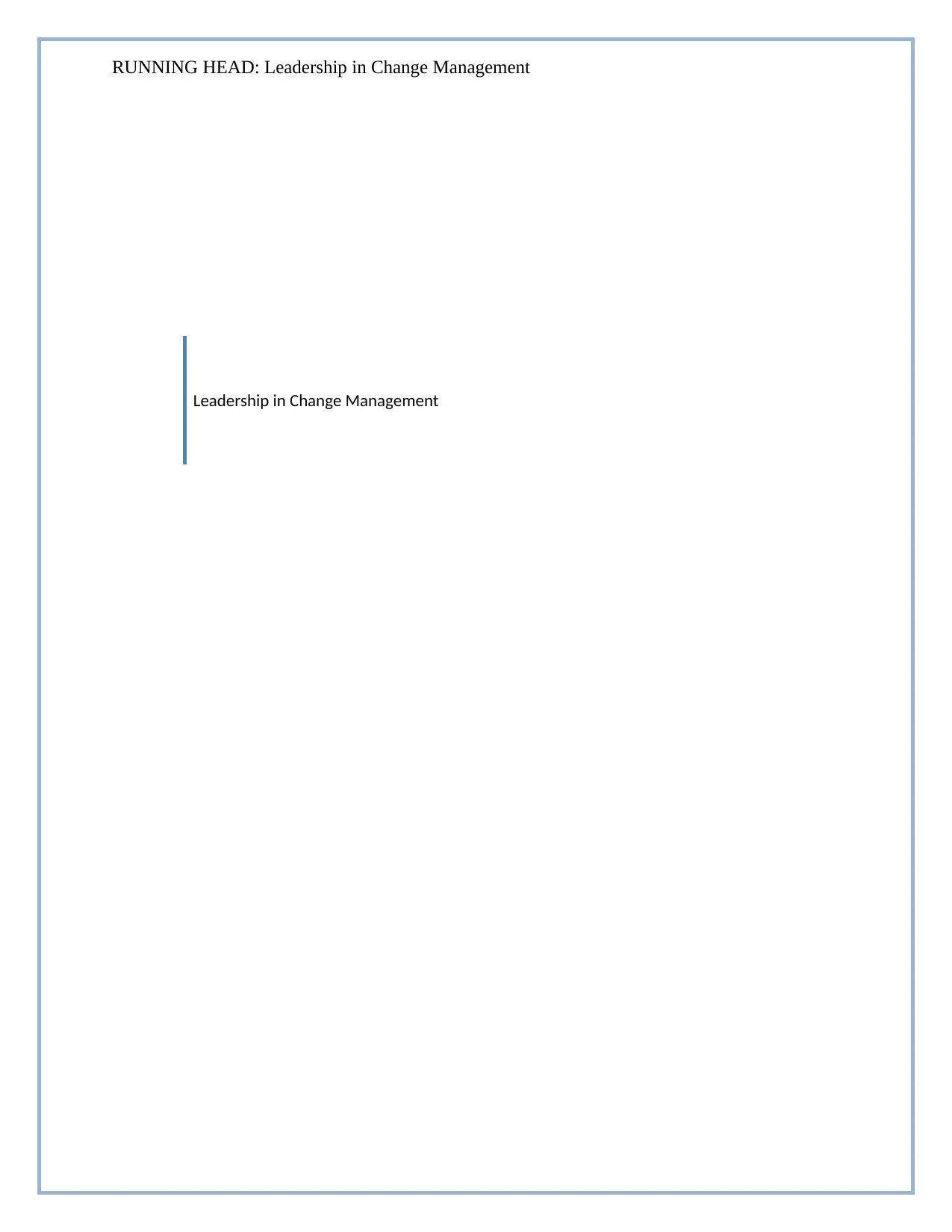
RUNNING HEAD: Leadership in Change Management
Leadership in Change Management
Leadership in Change Management
Paraphrase This Document
Need a fresh take? Get an instant paraphrase of this document with our AI Paraphraser
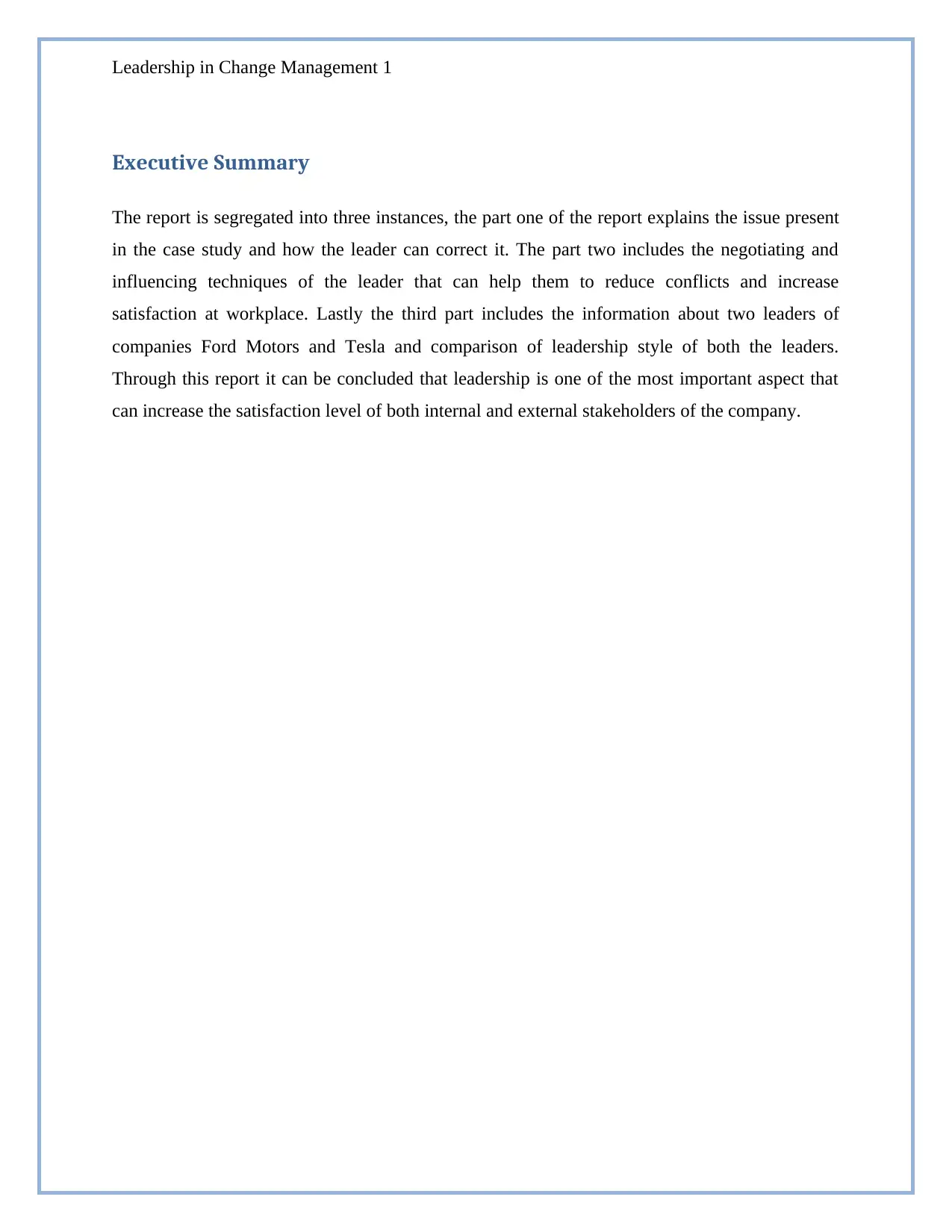
Leadership in Change Management 1
Executive Summary
The report is segregated into three instances, the part one of the report explains the issue present
in the case study and how the leader can correct it. The part two includes the negotiating and
influencing techniques of the leader that can help them to reduce conflicts and increase
satisfaction at workplace. Lastly the third part includes the information about two leaders of
companies Ford Motors and Tesla and comparison of leadership style of both the leaders.
Through this report it can be concluded that leadership is one of the most important aspect that
can increase the satisfaction level of both internal and external stakeholders of the company.
Executive Summary
The report is segregated into three instances, the part one of the report explains the issue present
in the case study and how the leader can correct it. The part two includes the negotiating and
influencing techniques of the leader that can help them to reduce conflicts and increase
satisfaction at workplace. Lastly the third part includes the information about two leaders of
companies Ford Motors and Tesla and comparison of leadership style of both the leaders.
Through this report it can be concluded that leadership is one of the most important aspect that
can increase the satisfaction level of both internal and external stakeholders of the company.
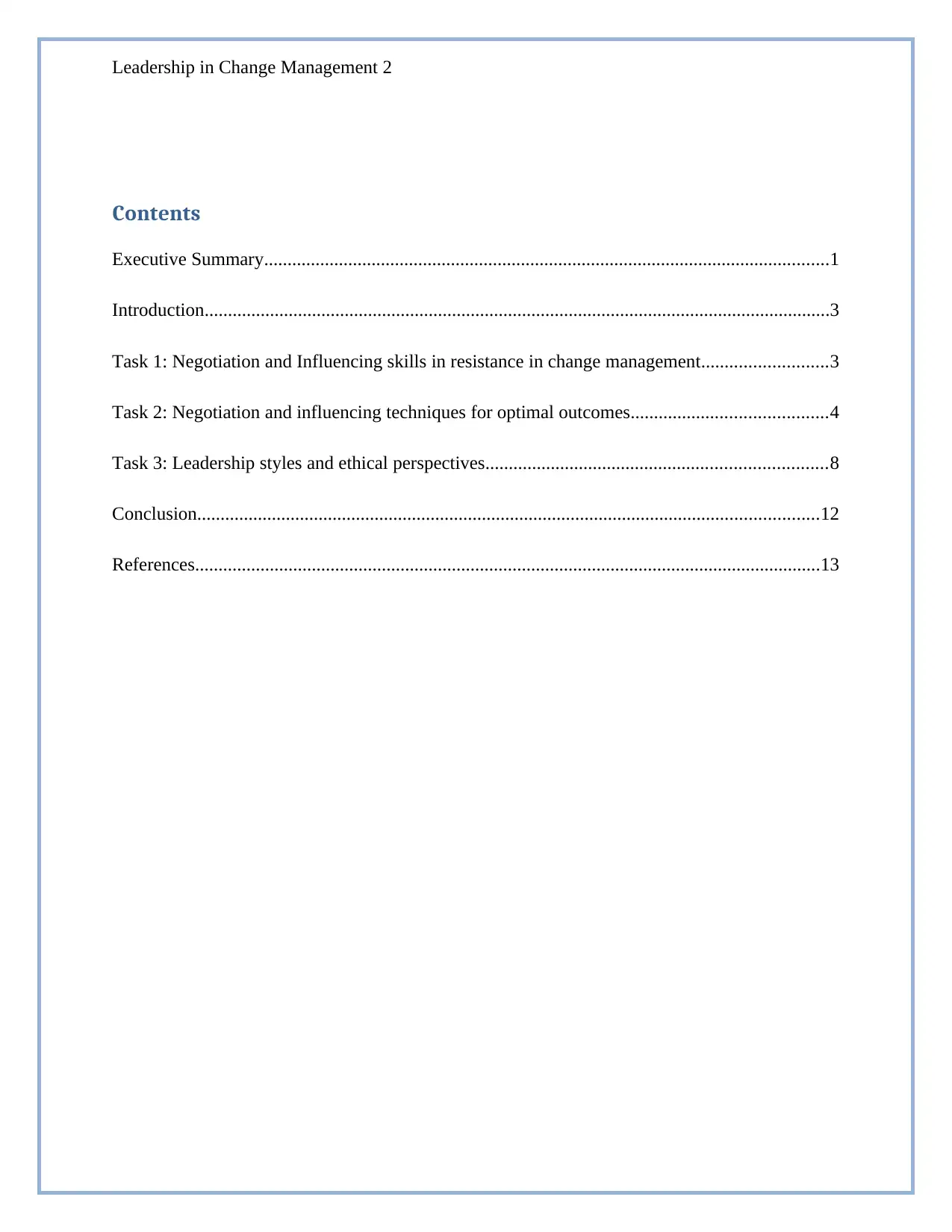
Leadership in Change Management 2
Contents
Executive Summary.........................................................................................................................1
Introduction......................................................................................................................................3
Task 1: Negotiation and Influencing skills in resistance in change management...........................3
Task 2: Negotiation and influencing techniques for optimal outcomes..........................................4
Task 3: Leadership styles and ethical perspectives.........................................................................8
Conclusion.....................................................................................................................................12
References......................................................................................................................................13
Contents
Executive Summary.........................................................................................................................1
Introduction......................................................................................................................................3
Task 1: Negotiation and Influencing skills in resistance in change management...........................3
Task 2: Negotiation and influencing techniques for optimal outcomes..........................................4
Task 3: Leadership styles and ethical perspectives.........................................................................8
Conclusion.....................................................................................................................................12
References......................................................................................................................................13
⊘ This is a preview!⊘
Do you want full access?
Subscribe today to unlock all pages.

Trusted by 1+ million students worldwide
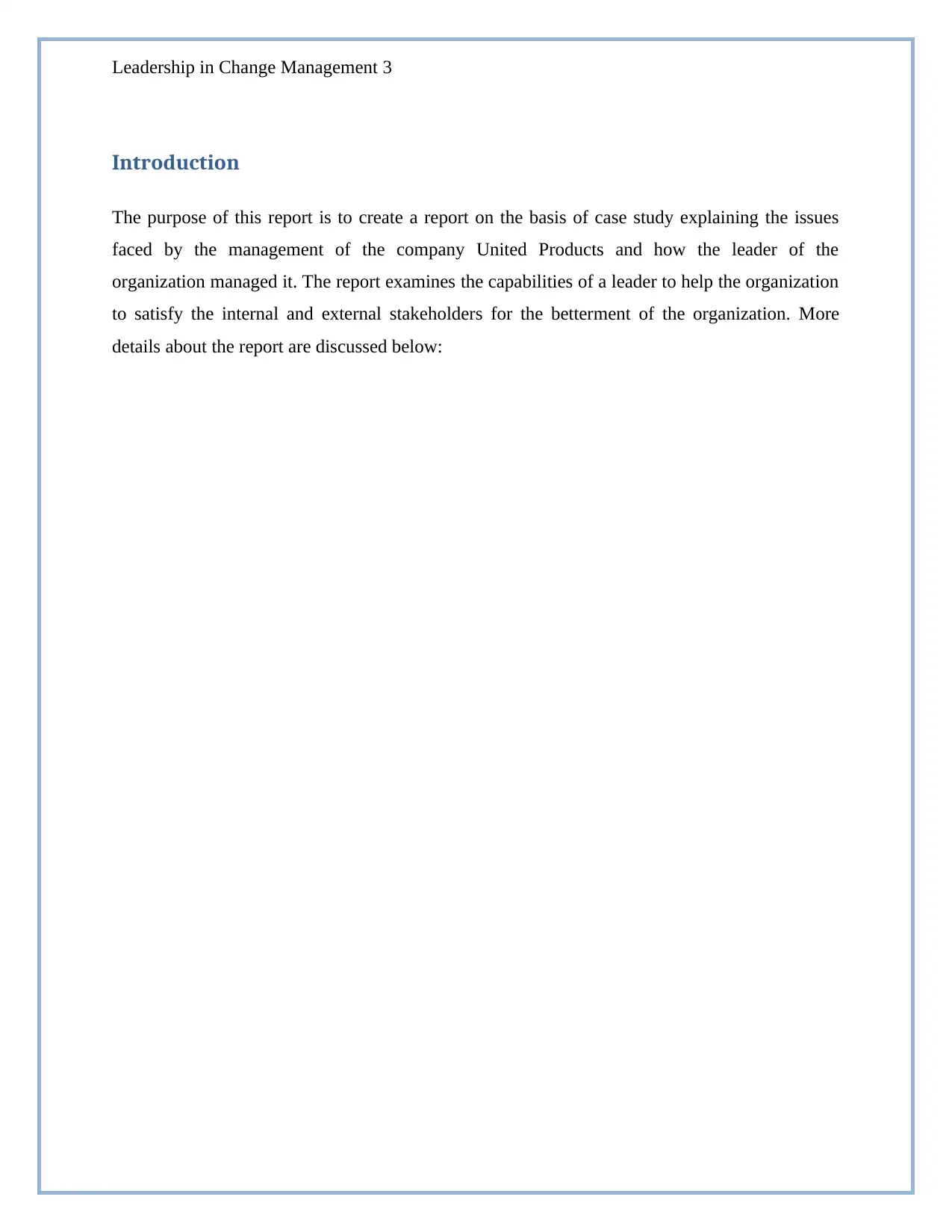
Leadership in Change Management 3
Introduction
The purpose of this report is to create a report on the basis of case study explaining the issues
faced by the management of the company United Products and how the leader of the
organization managed it. The report examines the capabilities of a leader to help the organization
to satisfy the internal and external stakeholders for the betterment of the organization. More
details about the report are discussed below:
Introduction
The purpose of this report is to create a report on the basis of case study explaining the issues
faced by the management of the company United Products and how the leader of the
organization managed it. The report examines the capabilities of a leader to help the organization
to satisfy the internal and external stakeholders for the betterment of the organization. More
details about the report are discussed below:
Paraphrase This Document
Need a fresh take? Get an instant paraphrase of this document with our AI Paraphraser
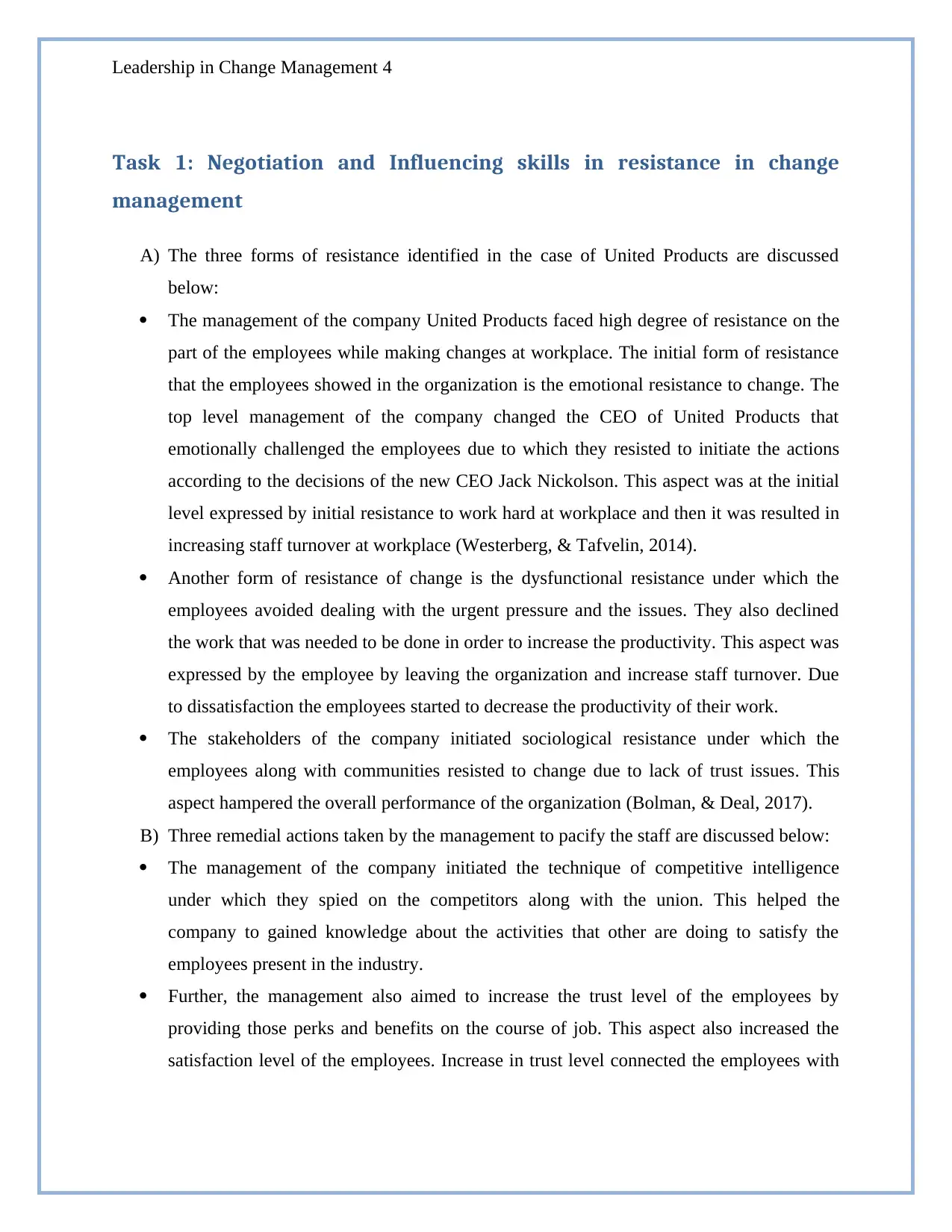
Leadership in Change Management 4
Task 1: Negotiation and Influencing skills in resistance in change
management
A) The three forms of resistance identified in the case of United Products are discussed
below:
The management of the company United Products faced high degree of resistance on the
part of the employees while making changes at workplace. The initial form of resistance
that the employees showed in the organization is the emotional resistance to change. The
top level management of the company changed the CEO of United Products that
emotionally challenged the employees due to which they resisted to initiate the actions
according to the decisions of the new CEO Jack Nickolson. This aspect was at the initial
level expressed by initial resistance to work hard at workplace and then it was resulted in
increasing staff turnover at workplace (Westerberg, & Tafvelin, 2014).
Another form of resistance of change is the dysfunctional resistance under which the
employees avoided dealing with the urgent pressure and the issues. They also declined
the work that was needed to be done in order to increase the productivity. This aspect was
expressed by the employee by leaving the organization and increase staff turnover. Due
to dissatisfaction the employees started to decrease the productivity of their work.
The stakeholders of the company initiated sociological resistance under which the
employees along with communities resisted to change due to lack of trust issues. This
aspect hampered the overall performance of the organization (Bolman, & Deal, 2017).
B) Three remedial actions taken by the management to pacify the staff are discussed below:
The management of the company initiated the technique of competitive intelligence
under which they spied on the competitors along with the union. This helped the
company to gained knowledge about the activities that other are doing to satisfy the
employees present in the industry.
Further, the management also aimed to increase the trust level of the employees by
providing those perks and benefits on the course of job. This aspect also increased the
satisfaction level of the employees. Increase in trust level connected the employees with
Task 1: Negotiation and Influencing skills in resistance in change
management
A) The three forms of resistance identified in the case of United Products are discussed
below:
The management of the company United Products faced high degree of resistance on the
part of the employees while making changes at workplace. The initial form of resistance
that the employees showed in the organization is the emotional resistance to change. The
top level management of the company changed the CEO of United Products that
emotionally challenged the employees due to which they resisted to initiate the actions
according to the decisions of the new CEO Jack Nickolson. This aspect was at the initial
level expressed by initial resistance to work hard at workplace and then it was resulted in
increasing staff turnover at workplace (Westerberg, & Tafvelin, 2014).
Another form of resistance of change is the dysfunctional resistance under which the
employees avoided dealing with the urgent pressure and the issues. They also declined
the work that was needed to be done in order to increase the productivity. This aspect was
expressed by the employee by leaving the organization and increase staff turnover. Due
to dissatisfaction the employees started to decrease the productivity of their work.
The stakeholders of the company initiated sociological resistance under which the
employees along with communities resisted to change due to lack of trust issues. This
aspect hampered the overall performance of the organization (Bolman, & Deal, 2017).
B) Three remedial actions taken by the management to pacify the staff are discussed below:
The management of the company initiated the technique of competitive intelligence
under which they spied on the competitors along with the union. This helped the
company to gained knowledge about the activities that other are doing to satisfy the
employees present in the industry.
Further, the management also aimed to increase the trust level of the employees by
providing those perks and benefits on the course of job. This aspect also increased the
satisfaction level of the employees. Increase in trust level connected the employees with
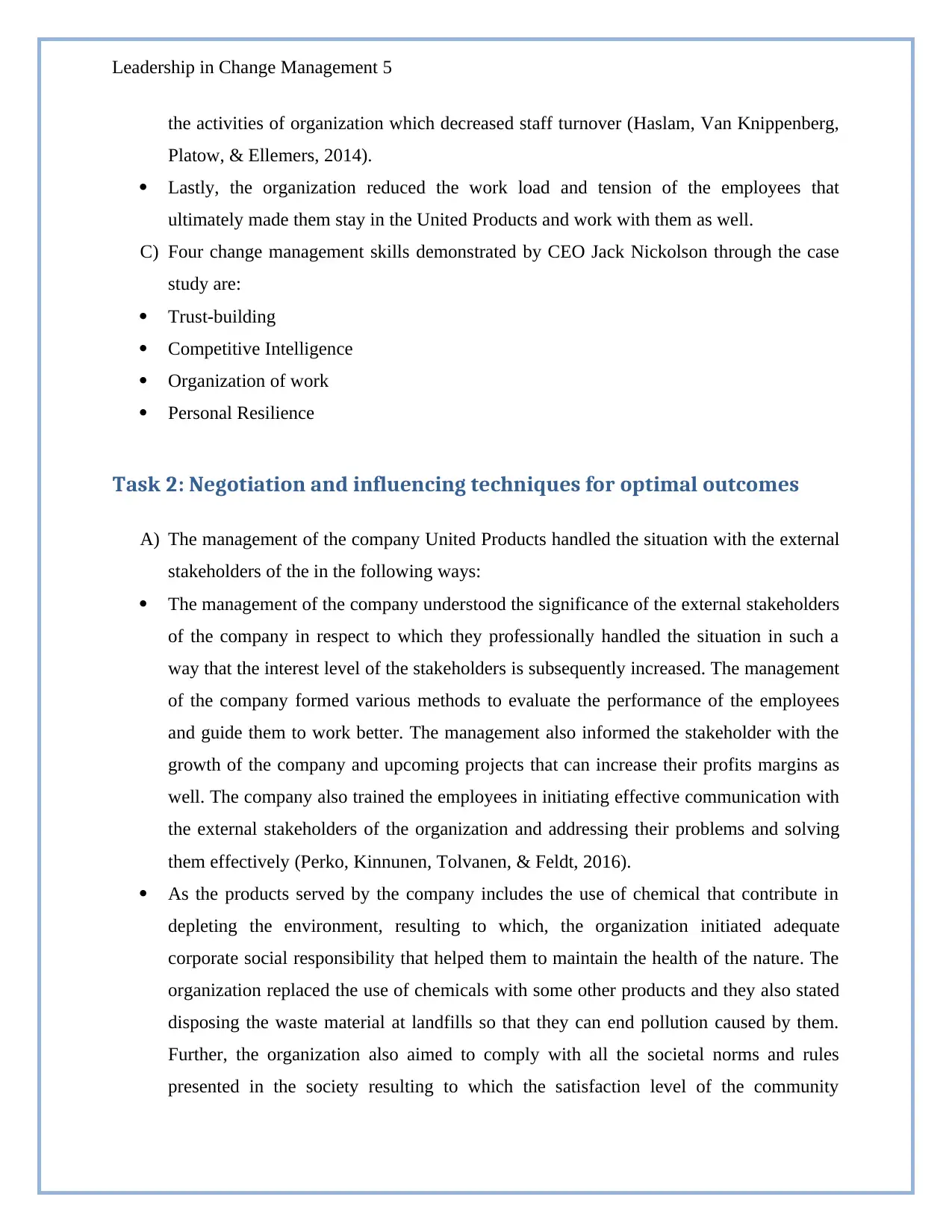
Leadership in Change Management 5
the activities of organization which decreased staff turnover (Haslam, Van Knippenberg,
Platow, & Ellemers, 2014).
Lastly, the organization reduced the work load and tension of the employees that
ultimately made them stay in the United Products and work with them as well.
C) Four change management skills demonstrated by CEO Jack Nickolson through the case
study are:
Trust-building
Competitive Intelligence
Organization of work
Personal Resilience
Task 2: Negotiation and influencing techniques for optimal outcomes
A) The management of the company United Products handled the situation with the external
stakeholders of the in the following ways:
The management of the company understood the significance of the external stakeholders
of the company in respect to which they professionally handled the situation in such a
way that the interest level of the stakeholders is subsequently increased. The management
of the company formed various methods to evaluate the performance of the employees
and guide them to work better. The management also informed the stakeholder with the
growth of the company and upcoming projects that can increase their profits margins as
well. The company also trained the employees in initiating effective communication with
the external stakeholders of the organization and addressing their problems and solving
them effectively (Perko, Kinnunen, Tolvanen, & Feldt, 2016).
As the products served by the company includes the use of chemical that contribute in
depleting the environment, resulting to which, the organization initiated adequate
corporate social responsibility that helped them to maintain the health of the nature. The
organization replaced the use of chemicals with some other products and they also stated
disposing the waste material at landfills so that they can end pollution caused by them.
Further, the organization also aimed to comply with all the societal norms and rules
presented in the society resulting to which the satisfaction level of the community
the activities of organization which decreased staff turnover (Haslam, Van Knippenberg,
Platow, & Ellemers, 2014).
Lastly, the organization reduced the work load and tension of the employees that
ultimately made them stay in the United Products and work with them as well.
C) Four change management skills demonstrated by CEO Jack Nickolson through the case
study are:
Trust-building
Competitive Intelligence
Organization of work
Personal Resilience
Task 2: Negotiation and influencing techniques for optimal outcomes
A) The management of the company United Products handled the situation with the external
stakeholders of the in the following ways:
The management of the company understood the significance of the external stakeholders
of the company in respect to which they professionally handled the situation in such a
way that the interest level of the stakeholders is subsequently increased. The management
of the company formed various methods to evaluate the performance of the employees
and guide them to work better. The management also informed the stakeholder with the
growth of the company and upcoming projects that can increase their profits margins as
well. The company also trained the employees in initiating effective communication with
the external stakeholders of the organization and addressing their problems and solving
them effectively (Perko, Kinnunen, Tolvanen, & Feldt, 2016).
As the products served by the company includes the use of chemical that contribute in
depleting the environment, resulting to which, the organization initiated adequate
corporate social responsibility that helped them to maintain the health of the nature. The
organization replaced the use of chemicals with some other products and they also stated
disposing the waste material at landfills so that they can end pollution caused by them.
Further, the organization also aimed to comply with all the societal norms and rules
presented in the society resulting to which the satisfaction level of the community
⊘ This is a preview!⊘
Do you want full access?
Subscribe today to unlock all pages.

Trusted by 1+ million students worldwide
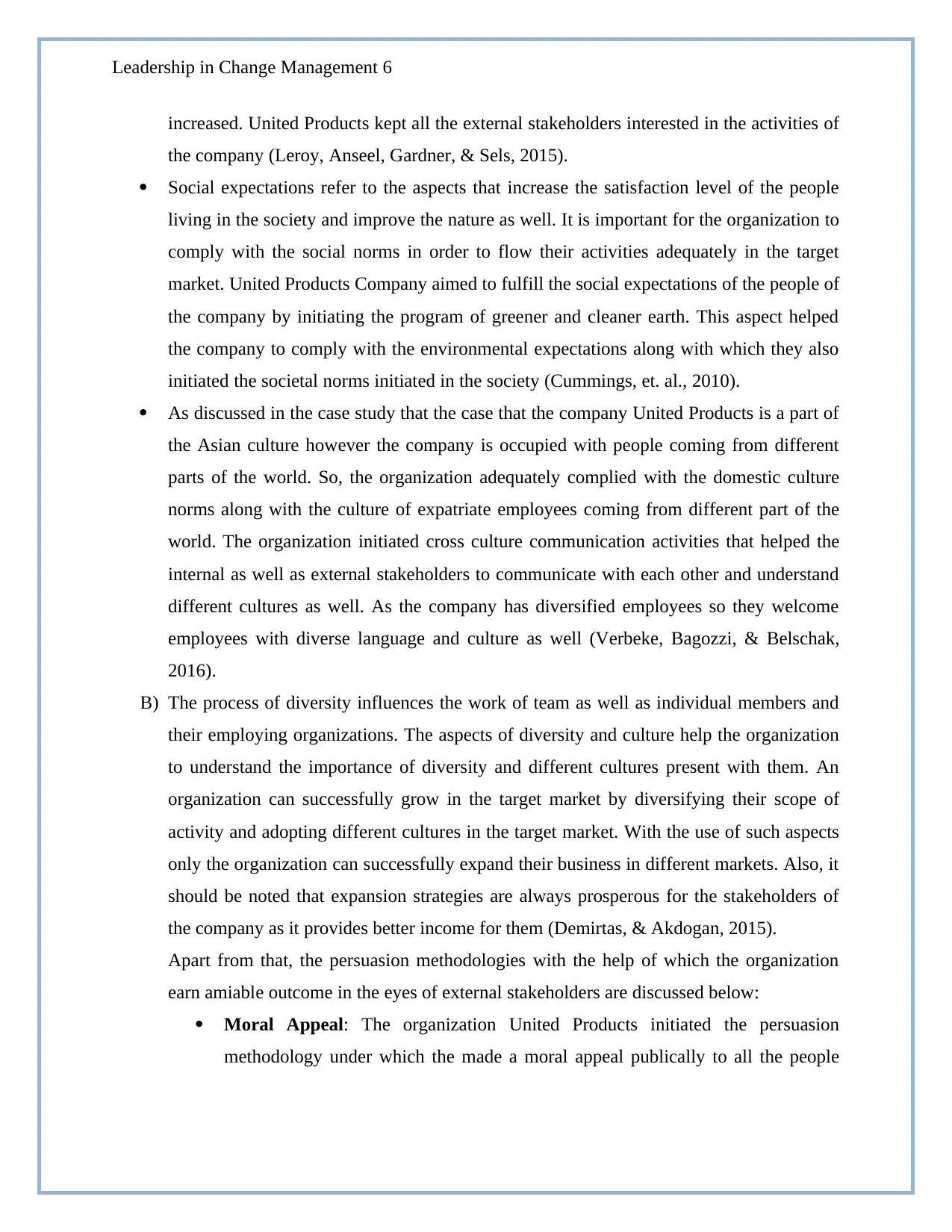
Leadership in Change Management 6
increased. United Products kept all the external stakeholders interested in the activities of
the company (Leroy, Anseel, Gardner, & Sels, 2015).
Social expectations refer to the aspects that increase the satisfaction level of the people
living in the society and improve the nature as well. It is important for the organization to
comply with the social norms in order to flow their activities adequately in the target
market. United Products Company aimed to fulfill the social expectations of the people of
the company by initiating the program of greener and cleaner earth. This aspect helped
the company to comply with the environmental expectations along with which they also
initiated the societal norms initiated in the society (Cummings, et. al., 2010).
As discussed in the case study that the case that the company United Products is a part of
the Asian culture however the company is occupied with people coming from different
parts of the world. So, the organization adequately complied with the domestic culture
norms along with the culture of expatriate employees coming from different part of the
world. The organization initiated cross culture communication activities that helped the
internal as well as external stakeholders to communicate with each other and understand
different cultures as well. As the company has diversified employees so they welcome
employees with diverse language and culture as well (Verbeke, Bagozzi, & Belschak,
2016).
B) The process of diversity influences the work of team as well as individual members and
their employing organizations. The aspects of diversity and culture help the organization
to understand the importance of diversity and different cultures present with them. An
organization can successfully grow in the target market by diversifying their scope of
activity and adopting different cultures in the target market. With the use of such aspects
only the organization can successfully expand their business in different markets. Also, it
should be noted that expansion strategies are always prosperous for the stakeholders of
the company as it provides better income for them (Demirtas, & Akdogan, 2015).
Apart from that, the persuasion methodologies with the help of which the organization
earn amiable outcome in the eyes of external stakeholders are discussed below:
Moral Appeal: The organization United Products initiated the persuasion
methodology under which the made a moral appeal publically to all the people
increased. United Products kept all the external stakeholders interested in the activities of
the company (Leroy, Anseel, Gardner, & Sels, 2015).
Social expectations refer to the aspects that increase the satisfaction level of the people
living in the society and improve the nature as well. It is important for the organization to
comply with the social norms in order to flow their activities adequately in the target
market. United Products Company aimed to fulfill the social expectations of the people of
the company by initiating the program of greener and cleaner earth. This aspect helped
the company to comply with the environmental expectations along with which they also
initiated the societal norms initiated in the society (Cummings, et. al., 2010).
As discussed in the case study that the case that the company United Products is a part of
the Asian culture however the company is occupied with people coming from different
parts of the world. So, the organization adequately complied with the domestic culture
norms along with the culture of expatriate employees coming from different part of the
world. The organization initiated cross culture communication activities that helped the
internal as well as external stakeholders to communicate with each other and understand
different cultures as well. As the company has diversified employees so they welcome
employees with diverse language and culture as well (Verbeke, Bagozzi, & Belschak,
2016).
B) The process of diversity influences the work of team as well as individual members and
their employing organizations. The aspects of diversity and culture help the organization
to understand the importance of diversity and different cultures present with them. An
organization can successfully grow in the target market by diversifying their scope of
activity and adopting different cultures in the target market. With the use of such aspects
only the organization can successfully expand their business in different markets. Also, it
should be noted that expansion strategies are always prosperous for the stakeholders of
the company as it provides better income for them (Demirtas, & Akdogan, 2015).
Apart from that, the persuasion methodologies with the help of which the organization
earn amiable outcome in the eyes of external stakeholders are discussed below:
Moral Appeal: The organization United Products initiated the persuasion
methodology under which the made a moral appeal publically to all the people
Paraphrase This Document
Need a fresh take? Get an instant paraphrase of this document with our AI Paraphraser
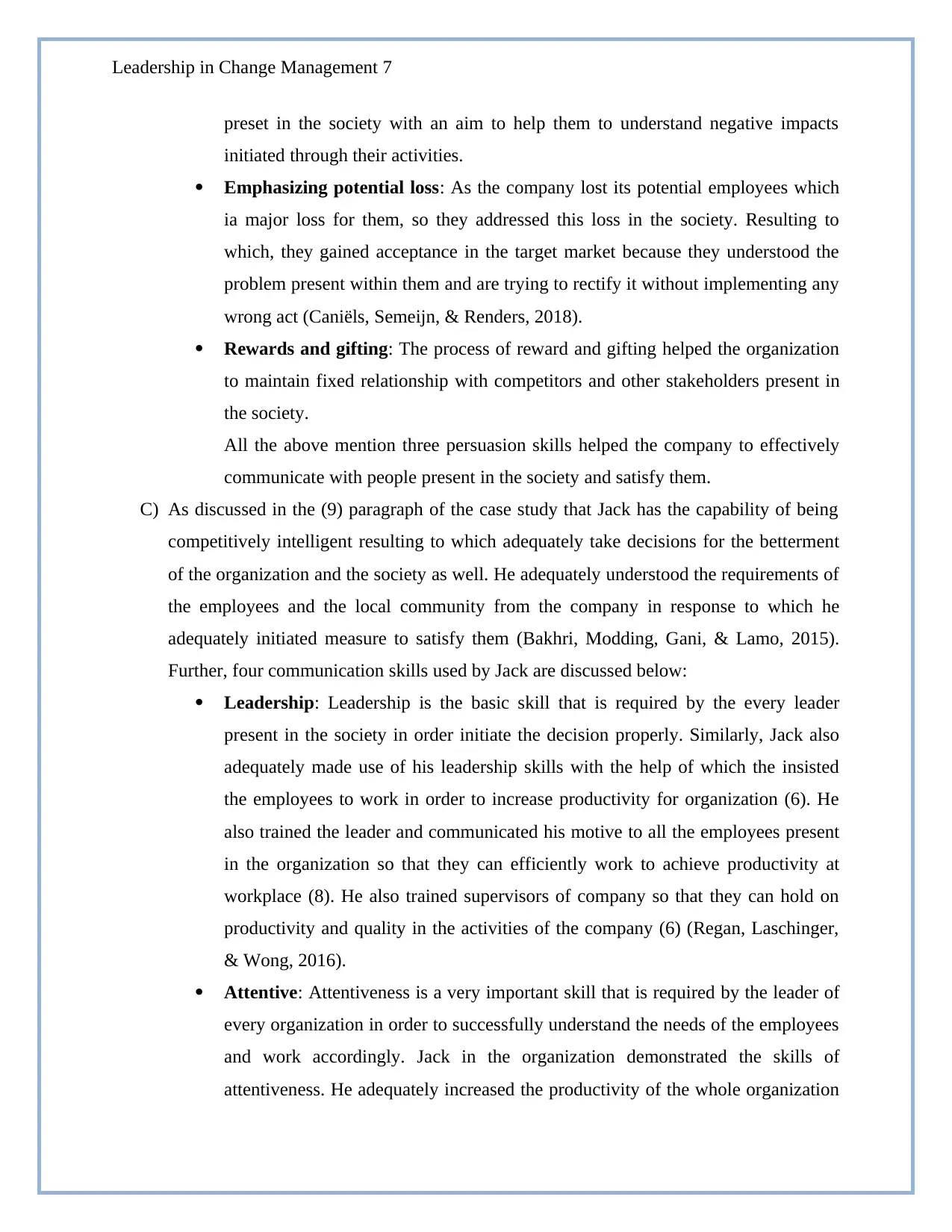
Leadership in Change Management 7
preset in the society with an aim to help them to understand negative impacts
initiated through their activities.
Emphasizing potential loss: As the company lost its potential employees which
ia major loss for them, so they addressed this loss in the society. Resulting to
which, they gained acceptance in the target market because they understood the
problem present within them and are trying to rectify it without implementing any
wrong act (Caniëls, Semeijn, & Renders, 2018).
Rewards and gifting: The process of reward and gifting helped the organization
to maintain fixed relationship with competitors and other stakeholders present in
the society.
All the above mention three persuasion skills helped the company to effectively
communicate with people present in the society and satisfy them.
C) As discussed in the (9) paragraph of the case study that Jack has the capability of being
competitively intelligent resulting to which adequately take decisions for the betterment
of the organization and the society as well. He adequately understood the requirements of
the employees and the local community from the company in response to which he
adequately initiated measure to satisfy them (Bakhri, Modding, Gani, & Lamo, 2015).
Further, four communication skills used by Jack are discussed below:
Leadership: Leadership is the basic skill that is required by the every leader
present in the society in order initiate the decision properly. Similarly, Jack also
adequately made use of his leadership skills with the help of which the insisted
the employees to work in order to increase productivity for organization (6). He
also trained the leader and communicated his motive to all the employees present
in the organization so that they can efficiently work to achieve productivity at
workplace (8). He also trained supervisors of company so that they can hold on
productivity and quality in the activities of the company (6) (Regan, Laschinger,
& Wong, 2016).
Attentive: Attentiveness is a very important skill that is required by the leader of
every organization in order to successfully understand the needs of the employees
and work accordingly. Jack in the organization demonstrated the skills of
attentiveness. He adequately increased the productivity of the whole organization
preset in the society with an aim to help them to understand negative impacts
initiated through their activities.
Emphasizing potential loss: As the company lost its potential employees which
ia major loss for them, so they addressed this loss in the society. Resulting to
which, they gained acceptance in the target market because they understood the
problem present within them and are trying to rectify it without implementing any
wrong act (Caniëls, Semeijn, & Renders, 2018).
Rewards and gifting: The process of reward and gifting helped the organization
to maintain fixed relationship with competitors and other stakeholders present in
the society.
All the above mention three persuasion skills helped the company to effectively
communicate with people present in the society and satisfy them.
C) As discussed in the (9) paragraph of the case study that Jack has the capability of being
competitively intelligent resulting to which adequately take decisions for the betterment
of the organization and the society as well. He adequately understood the requirements of
the employees and the local community from the company in response to which he
adequately initiated measure to satisfy them (Bakhri, Modding, Gani, & Lamo, 2015).
Further, four communication skills used by Jack are discussed below:
Leadership: Leadership is the basic skill that is required by the every leader
present in the society in order initiate the decision properly. Similarly, Jack also
adequately made use of his leadership skills with the help of which the insisted
the employees to work in order to increase productivity for organization (6). He
also trained the leader and communicated his motive to all the employees present
in the organization so that they can efficiently work to achieve productivity at
workplace (8). He also trained supervisors of company so that they can hold on
productivity and quality in the activities of the company (6) (Regan, Laschinger,
& Wong, 2016).
Attentive: Attentiveness is a very important skill that is required by the leader of
every organization in order to successfully understand the needs of the employees
and work accordingly. Jack in the organization demonstrated the skills of
attentiveness. He adequately increased the productivity of the whole organization
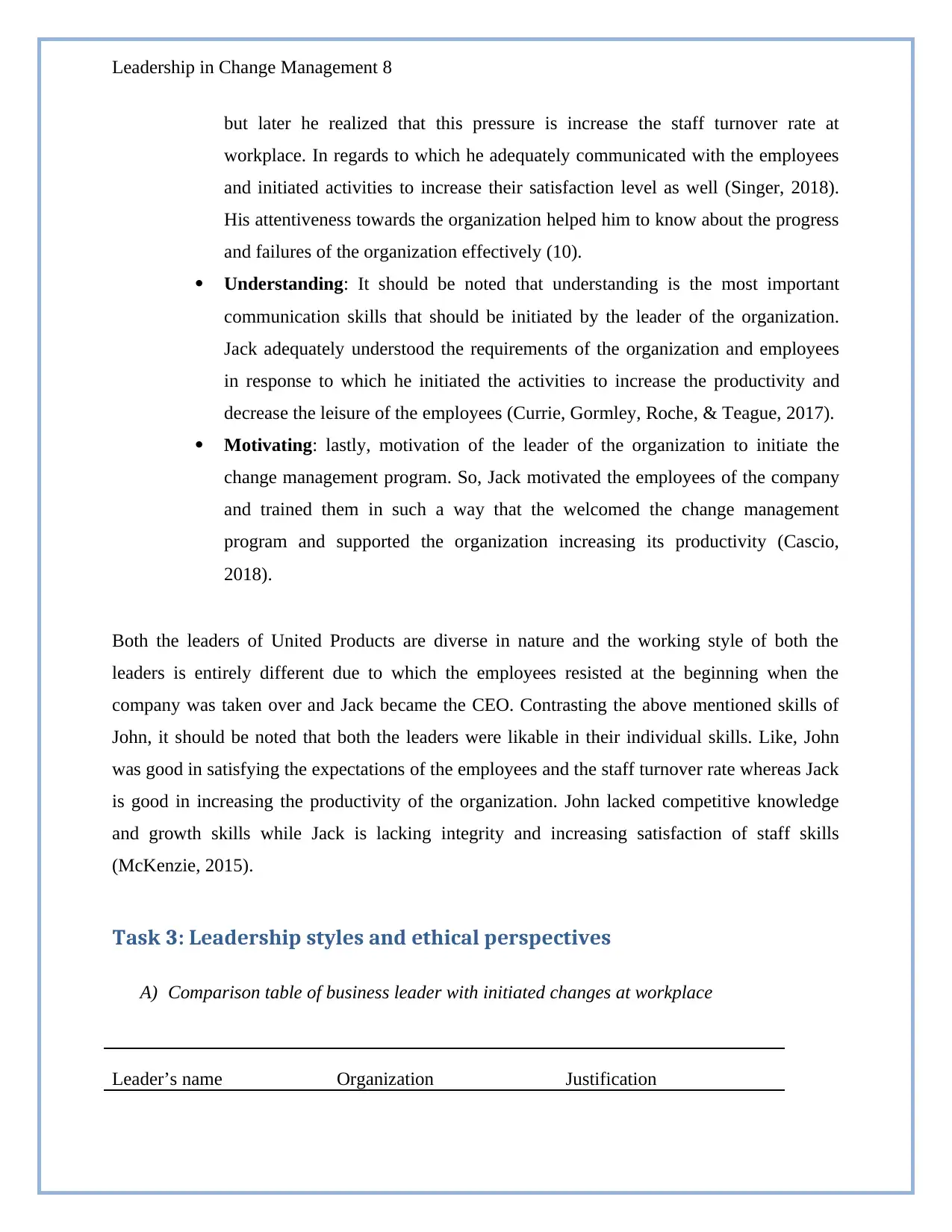
Leadership in Change Management 8
but later he realized that this pressure is increase the staff turnover rate at
workplace. In regards to which he adequately communicated with the employees
and initiated activities to increase their satisfaction level as well (Singer, 2018).
His attentiveness towards the organization helped him to know about the progress
and failures of the organization effectively (10).
Understanding: It should be noted that understanding is the most important
communication skills that should be initiated by the leader of the organization.
Jack adequately understood the requirements of the organization and employees
in response to which he initiated the activities to increase the productivity and
decrease the leisure of the employees (Currie, Gormley, Roche, & Teague, 2017).
Motivating: lastly, motivation of the leader of the organization to initiate the
change management program. So, Jack motivated the employees of the company
and trained them in such a way that the welcomed the change management
program and supported the organization increasing its productivity (Cascio,
2018).
Both the leaders of United Products are diverse in nature and the working style of both the
leaders is entirely different due to which the employees resisted at the beginning when the
company was taken over and Jack became the CEO. Contrasting the above mentioned skills of
John, it should be noted that both the leaders were likable in their individual skills. Like, John
was good in satisfying the expectations of the employees and the staff turnover rate whereas Jack
is good in increasing the productivity of the organization. John lacked competitive knowledge
and growth skills while Jack is lacking integrity and increasing satisfaction of staff skills
(McKenzie, 2015).
Task 3: Leadership styles and ethical perspectives
A) Comparison table of business leader with initiated changes at workplace
Leader’s name Organization Justification
but later he realized that this pressure is increase the staff turnover rate at
workplace. In regards to which he adequately communicated with the employees
and initiated activities to increase their satisfaction level as well (Singer, 2018).
His attentiveness towards the organization helped him to know about the progress
and failures of the organization effectively (10).
Understanding: It should be noted that understanding is the most important
communication skills that should be initiated by the leader of the organization.
Jack adequately understood the requirements of the organization and employees
in response to which he initiated the activities to increase the productivity and
decrease the leisure of the employees (Currie, Gormley, Roche, & Teague, 2017).
Motivating: lastly, motivation of the leader of the organization to initiate the
change management program. So, Jack motivated the employees of the company
and trained them in such a way that the welcomed the change management
program and supported the organization increasing its productivity (Cascio,
2018).
Both the leaders of United Products are diverse in nature and the working style of both the
leaders is entirely different due to which the employees resisted at the beginning when the
company was taken over and Jack became the CEO. Contrasting the above mentioned skills of
John, it should be noted that both the leaders were likable in their individual skills. Like, John
was good in satisfying the expectations of the employees and the staff turnover rate whereas Jack
is good in increasing the productivity of the organization. John lacked competitive knowledge
and growth skills while Jack is lacking integrity and increasing satisfaction of staff skills
(McKenzie, 2015).
Task 3: Leadership styles and ethical perspectives
A) Comparison table of business leader with initiated changes at workplace
Leader’s name Organization Justification
⊘ This is a preview!⊘
Do you want full access?
Subscribe today to unlock all pages.

Trusted by 1+ million students worldwide
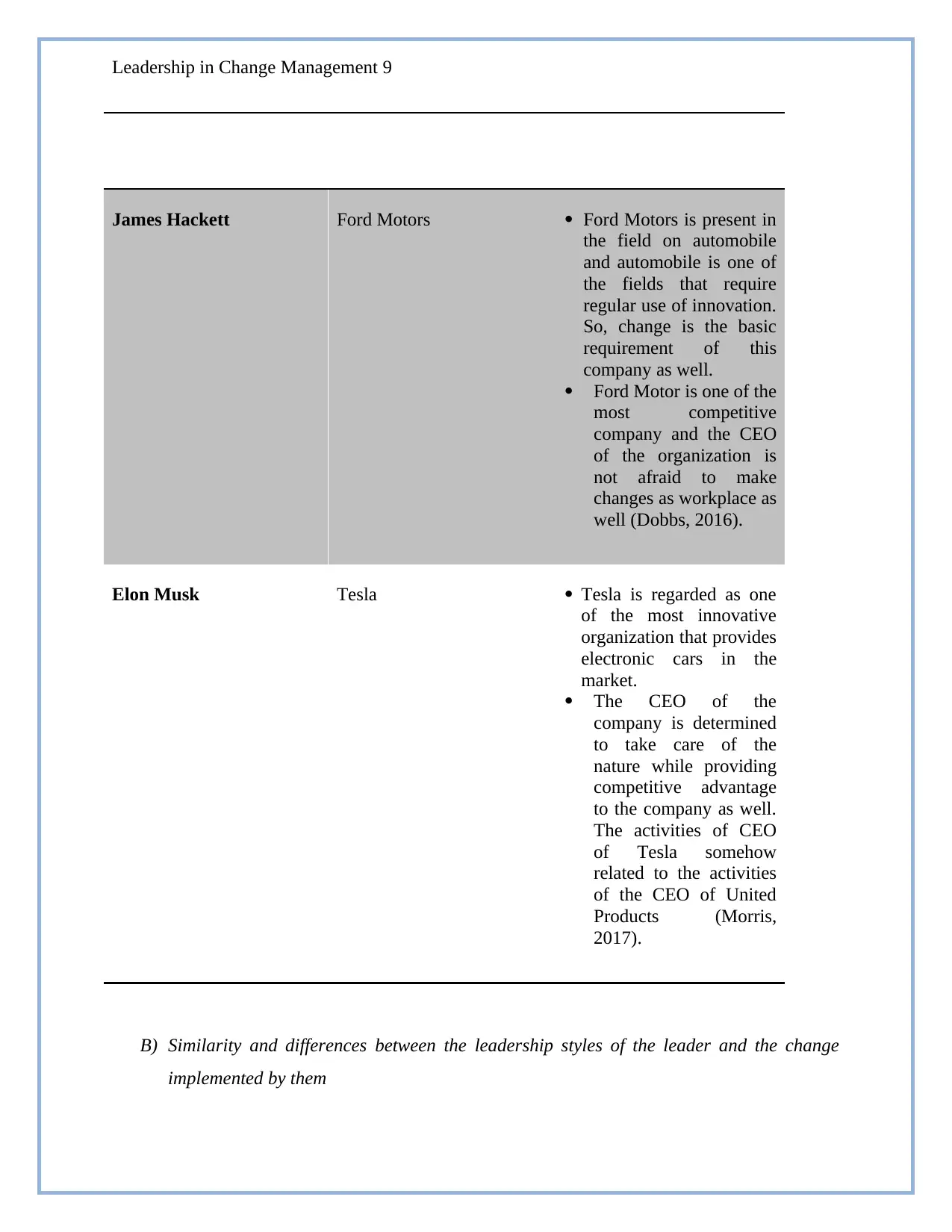
Leadership in Change Management 9
James Hackett Ford Motors Ford Motors is present in
the field on automobile
and automobile is one of
the fields that require
regular use of innovation.
So, change is the basic
requirement of this
company as well.
Ford Motor is one of the
most competitive
company and the CEO
of the organization is
not afraid to make
changes as workplace as
well (Dobbs, 2016).
Elon Musk Tesla Tesla is regarded as one
of the most innovative
organization that provides
electronic cars in the
market.
The CEO of the
company is determined
to take care of the
nature while providing
competitive advantage
to the company as well.
The activities of CEO
of Tesla somehow
related to the activities
of the CEO of United
Products (Morris,
2017).
B) Similarity and differences between the leadership styles of the leader and the change
implemented by them
James Hackett Ford Motors Ford Motors is present in
the field on automobile
and automobile is one of
the fields that require
regular use of innovation.
So, change is the basic
requirement of this
company as well.
Ford Motor is one of the
most competitive
company and the CEO
of the organization is
not afraid to make
changes as workplace as
well (Dobbs, 2016).
Elon Musk Tesla Tesla is regarded as one
of the most innovative
organization that provides
electronic cars in the
market.
The CEO of the
company is determined
to take care of the
nature while providing
competitive advantage
to the company as well.
The activities of CEO
of Tesla somehow
related to the activities
of the CEO of United
Products (Morris,
2017).
B) Similarity and differences between the leadership styles of the leader and the change
implemented by them
Paraphrase This Document
Need a fresh take? Get an instant paraphrase of this document with our AI Paraphraser
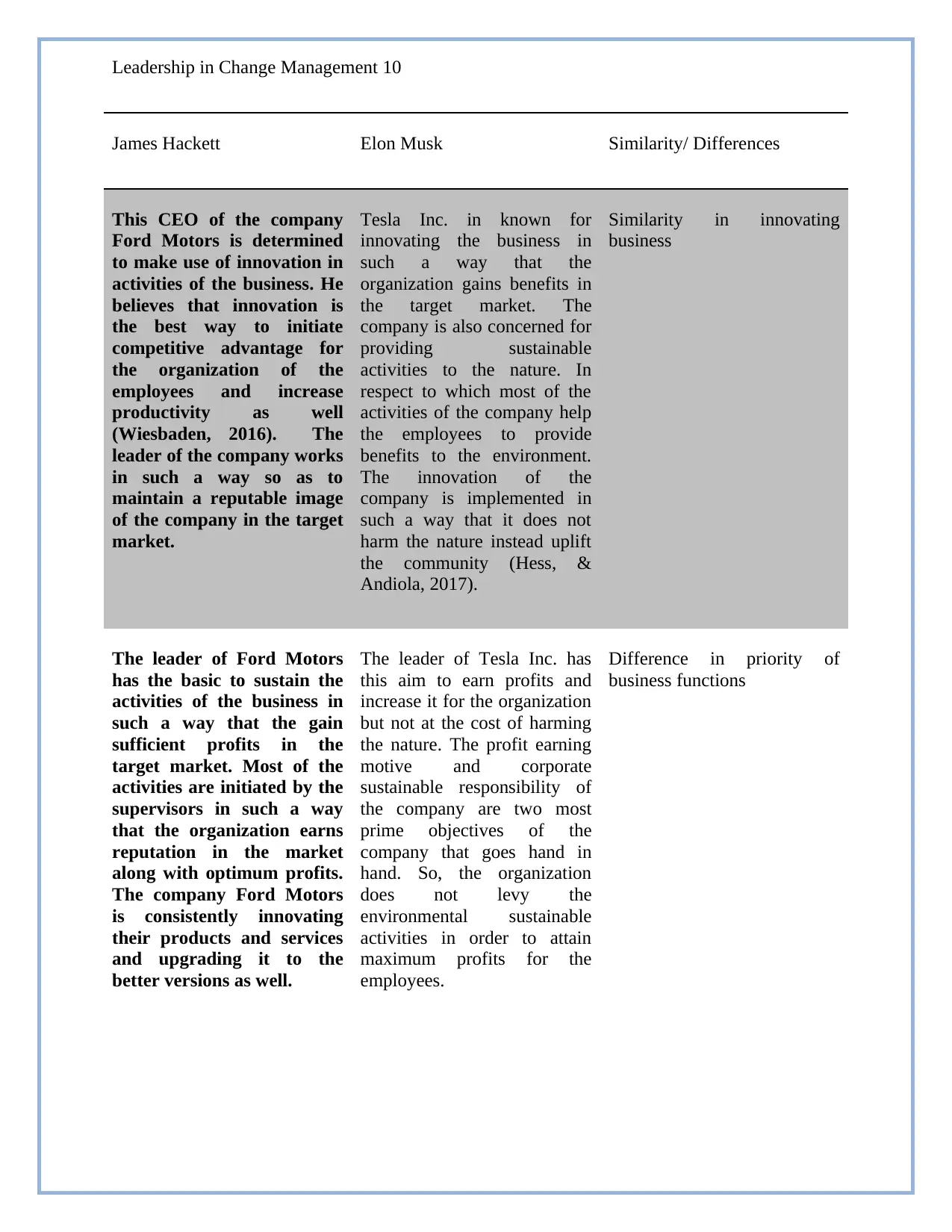
Leadership in Change Management 10
James Hackett Elon Musk Similarity/ Differences
This CEO of the company
Ford Motors is determined
to make use of innovation in
activities of the business. He
believes that innovation is
the best way to initiate
competitive advantage for
the organization of the
employees and increase
productivity as well
(Wiesbaden, 2016). The
leader of the company works
in such a way so as to
maintain a reputable image
of the company in the target
market.
Tesla Inc. in known for
innovating the business in
such a way that the
organization gains benefits in
the target market. The
company is also concerned for
providing sustainable
activities to the nature. In
respect to which most of the
activities of the company help
the employees to provide
benefits to the environment.
The innovation of the
company is implemented in
such a way that it does not
harm the nature instead uplift
the community (Hess, &
Andiola, 2017).
Similarity in innovating
business
The leader of Ford Motors
has the basic to sustain the
activities of the business in
such a way that the gain
sufficient profits in the
target market. Most of the
activities are initiated by the
supervisors in such a way
that the organization earns
reputation in the market
along with optimum profits.
The company Ford Motors
is consistently innovating
their products and services
and upgrading it to the
better versions as well.
The leader of Tesla Inc. has
this aim to earn profits and
increase it for the organization
but not at the cost of harming
the nature. The profit earning
motive and corporate
sustainable responsibility of
the company are two most
prime objectives of the
company that goes hand in
hand. So, the organization
does not levy the
environmental sustainable
activities in order to attain
maximum profits for the
employees.
Difference in priority of
business functions
James Hackett Elon Musk Similarity/ Differences
This CEO of the company
Ford Motors is determined
to make use of innovation in
activities of the business. He
believes that innovation is
the best way to initiate
competitive advantage for
the organization of the
employees and increase
productivity as well
(Wiesbaden, 2016). The
leader of the company works
in such a way so as to
maintain a reputable image
of the company in the target
market.
Tesla Inc. in known for
innovating the business in
such a way that the
organization gains benefits in
the target market. The
company is also concerned for
providing sustainable
activities to the nature. In
respect to which most of the
activities of the company help
the employees to provide
benefits to the environment.
The innovation of the
company is implemented in
such a way that it does not
harm the nature instead uplift
the community (Hess, &
Andiola, 2017).
Similarity in innovating
business
The leader of Ford Motors
has the basic to sustain the
activities of the business in
such a way that the gain
sufficient profits in the
target market. Most of the
activities are initiated by the
supervisors in such a way
that the organization earns
reputation in the market
along with optimum profits.
The company Ford Motors
is consistently innovating
their products and services
and upgrading it to the
better versions as well.
The leader of Tesla Inc. has
this aim to earn profits and
increase it for the organization
but not at the cost of harming
the nature. The profit earning
motive and corporate
sustainable responsibility of
the company are two most
prime objectives of the
company that goes hand in
hand. So, the organization
does not levy the
environmental sustainable
activities in order to attain
maximum profits for the
employees.
Difference in priority of
business functions
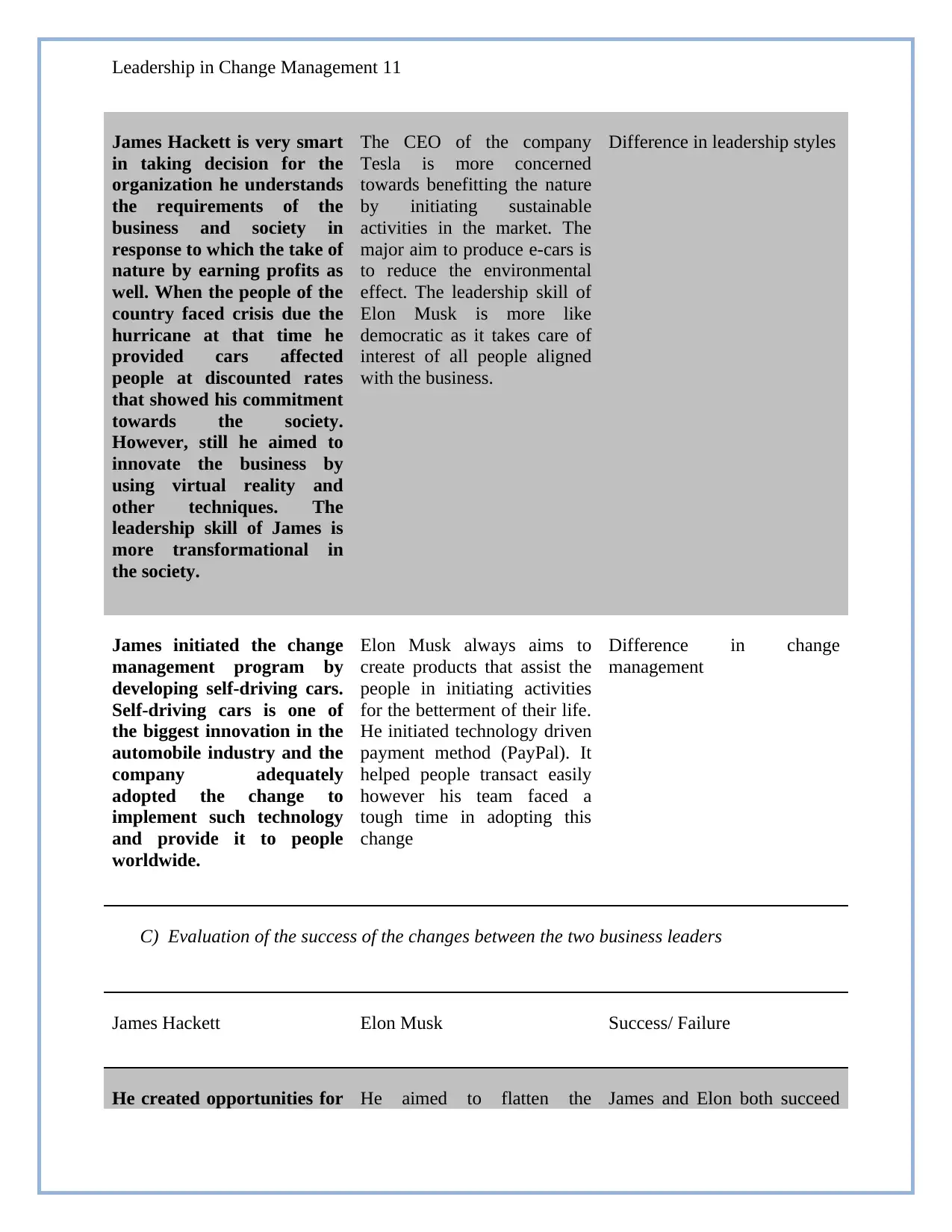
Leadership in Change Management 11
James Hackett is very smart
in taking decision for the
organization he understands
the requirements of the
business and society in
response to which the take of
nature by earning profits as
well. When the people of the
country faced crisis due the
hurricane at that time he
provided cars affected
people at discounted rates
that showed his commitment
towards the society.
However, still he aimed to
innovate the business by
using virtual reality and
other techniques. The
leadership skill of James is
more transformational in
the society.
The CEO of the company
Tesla is more concerned
towards benefitting the nature
by initiating sustainable
activities in the market. The
major aim to produce e-cars is
to reduce the environmental
effect. The leadership skill of
Elon Musk is more like
democratic as it takes care of
interest of all people aligned
with the business.
Difference in leadership styles
James initiated the change
management program by
developing self-driving cars.
Self-driving cars is one of
the biggest innovation in the
automobile industry and the
company adequately
adopted the change to
implement such technology
and provide it to people
worldwide.
Elon Musk always aims to
create products that assist the
people in initiating activities
for the betterment of their life.
He initiated technology driven
payment method (PayPal). It
helped people transact easily
however his team faced a
tough time in adopting this
change
Difference in change
management
C) Evaluation of the success of the changes between the two business leaders
James Hackett Elon Musk Success/ Failure
He created opportunities for He aimed to flatten the James and Elon both succeed
James Hackett is very smart
in taking decision for the
organization he understands
the requirements of the
business and society in
response to which the take of
nature by earning profits as
well. When the people of the
country faced crisis due the
hurricane at that time he
provided cars affected
people at discounted rates
that showed his commitment
towards the society.
However, still he aimed to
innovate the business by
using virtual reality and
other techniques. The
leadership skill of James is
more transformational in
the society.
The CEO of the company
Tesla is more concerned
towards benefitting the nature
by initiating sustainable
activities in the market. The
major aim to produce e-cars is
to reduce the environmental
effect. The leadership skill of
Elon Musk is more like
democratic as it takes care of
interest of all people aligned
with the business.
Difference in leadership styles
James initiated the change
management program by
developing self-driving cars.
Self-driving cars is one of
the biggest innovation in the
automobile industry and the
company adequately
adopted the change to
implement such technology
and provide it to people
worldwide.
Elon Musk always aims to
create products that assist the
people in initiating activities
for the betterment of their life.
He initiated technology driven
payment method (PayPal). It
helped people transact easily
however his team faced a
tough time in adopting this
change
Difference in change
management
C) Evaluation of the success of the changes between the two business leaders
James Hackett Elon Musk Success/ Failure
He created opportunities for He aimed to flatten the James and Elon both succeed
⊘ This is a preview!⊘
Do you want full access?
Subscribe today to unlock all pages.

Trusted by 1+ million students worldwide
1 out of 18
Related Documents
Your All-in-One AI-Powered Toolkit for Academic Success.
+13062052269
info@desklib.com
Available 24*7 on WhatsApp / Email
![[object Object]](/_next/static/media/star-bottom.7253800d.svg)
Unlock your academic potential
Copyright © 2020–2025 A2Z Services. All Rights Reserved. Developed and managed by ZUCOL.



